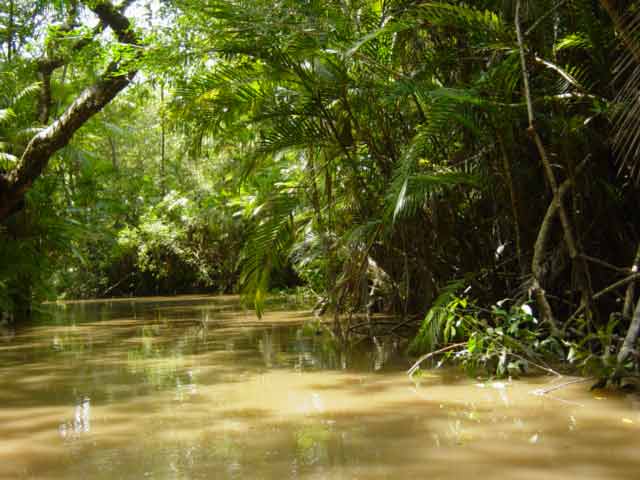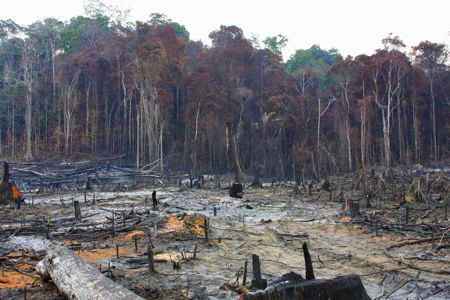Clearing for Cattle Pasture
- Cattle ranching is the leading cause of deforestation in the Brazilian Amazon. This has been the case since at least the 1970s: government figures attributed 38 percent of deforestation from 1966-1975 to large-scale cattle ranching. However, today the situation may be even worse.
- 91% of land deforested since 1970, is used for cattle pasture.Cattle breeding is traditional business in Brazil that gives huge profits (especially so, since meat prices are constantly rising), and what is equally important it doesn't require big maintenance expenditures. What it requires though is large area, and Amazon rain forest is the one that stands in the way of that high profit that could be earned. Clearing forest area for cattle pasture has contributed around 60-70 % of total deforestation, and is by far the biggest cause for tremendous deforestation in Amazon rain forest. Areas, once full of trees are now savannas and other coarse grasses needed for cattle pasture.
Several factors have spurred recent Brazil's growth as a producer of beef:
- CURRENCY DEVALUATION—The devaluation of the Brazilian real against the dollar effectively doubled the price of beef in reals and created an incentive for ranchers to expand their pasture areas at the expense of the rainforest. The weakness of the real also made Brazilian beef more competitive on the world market [CIFOR].
- CONTROL OVER FOOT-AND-MOUTH DISEASE—The eradication of foot-and-mouth disease in much of Brazil has increased price and demand for Brazilian beef.
- INFRASTRUCTURE—Road construction gives developers and ranchers access to previously inaccessible forest lands in the Amazon. Infrastructure improvements can reduce the costs of shipping and packing beef.
- INTEREST RATES—Rainforest lands are often used for land speculation purposes. When real pasture land prices exceed real forest land prices, land clearing is a good hedge against inflation. At times of high inflation, the appreciation of cattle prices and the stream of services (milk) they provide may outpace the interest rate earned on money left in the bank.
- LAND TENURE LAWS—In Brazil, colonists and developers can gain title to Amazon lands by simply clearing forest and placing a few head of cattle on the land. As an additional benefit, cattle are a low-risk investment relative to cash crops which are subject to wild price swings and pest infestations. Essentially cattle are a vehicle for land ownership in the Amazon.
Bio fuels
- When bio fuels were discovered, the government being driven by high profits, cleared out a large area of land in the Amazon rain forest for soy-bean production. Profits are so high that Brazil’s economy has made a remarkable growth in soybean production, so big that is in a matter of a day, Brazil becomes No. 1 soybean producer overtaking U.S. as the main producer. Farms are responsible for about 20 % of total Amazon rain forest deforestation but this percentage is steadily growing in last couple of years.
- Tropical rainforests are excellent sources of many quality and expensive wood (ebony), and this is the reason why many people turn to illegal logging as highly profitable business. Illegal logging is still big problem in Brazil, and there is still no adequate control that would put an end to the steady rise in illegal logging. Brazilian government still fails to take serious actions against illegal loggers, and the longer the government delays serious action the more Amazon rainforest gets cleared.
- According to scientists, Amazon logging companies extract or damage 10 to 40 percent of the live biomass of a forest area, and open up the canopy by 14 to 50 percent.The reduced canopy cover can also make the forests more vulnerable toforest fires. The indirect consequences of offsetting the cost of road building and forest clearance opens up the forest to further destructive activities including large-scale hunting, fuel wood gathering and clearing for agriculture.
- More than 90 percent of the logs seized were of ipe wood, a large tropical hardwood tree prized for its durability, strength and natural resistance to decay and insect infestation, they added. Ipe, an endangered species with the alluring nickname "Amazon gold," is worth more than $1,300 per cubic meter. These illegal loggers see this as a source of income.
Social Factors
Growing Population
- Since the human population is constantly growing, there is a need for more food and therefore a huge area of land have to be cleared out, so that it can be used for cattle pasture, to feed the growing population.
- Poverty is still a problem in Brazil, therefore the government has created more job opportunities by clearing land in the Amazon Forest by occupying the land with cattle pastures and soy-bean production( for Bio-fuel ). At the same time, this will help solve the problem, poverty and also help to boost the country’s economy significantly. Subsistence agriculture in a method of crop production, where farmers produce only enough food to feed the family. The practice of subsistence agriculture is done mainly by poor farmers that settle in forest land. The government encourages these farmers to settle on the land and earn ownership after five years of agricultural practice.
- However, most of these farmers engage in the slash and burn method. The slash and burn implies that farm land is burnt after crops are harvested. However, in most cases, the fires set in farmland end up spreading to forest land.
- Also, the slash and burn practice causes land to loose its productivity in about two years. This loss in productivity encourages land owners to clear more trees for crop cultivation. Between 1995 and 1998, the Brazilian government granted land to over 150 000 people This lead an increase in the amount of forest land lost due to slash and burn method.
- Poverty does drive people to migrate to forest frontiers, where they engage in slash and burn forest clearing for subsistence.
Transportation
- Road Building is the start of the deforestation chain. Roads provides the accessibility and therefore it is followed by logging that is both legal and illegal.
- Countries build roads into remote areas to improve overland transportation of goods. The road development itself causes a limited amount of deforestation. But roads also provide entry to previously inaccessible—and often unclaimed—land.
Graph: http://earthobservatory.nasa.gov/Features/Deforestation/deforestation_update3.php
Info:
- http://ecological-problems.blogspot.com/2010/01/amazon-rainforest-deforestation-main.html
- http://www.mongabay.com/brazil.html#cattle
- http://sites.google.com/site/littleije/home
- http://www.greenpeace.org/international/en/campaigns/forests/amazon/logging-in-the-amazon/
- http://www.google.com/hostednews/afp/article/ALeqM5hCWakDnVi6YtWRn7wMr1nD4_f8pA?docId=CNG.85cdacfb80b35ee0883c0c5d92b29bef.2c1
- http://agcarbonmarkets.com/documents/TCG%20White%20Paper_Agriculture%20and%20Deforestation_FINAL.pdf





